In the world of hypercars, few brands have left a mark as profound as Pagani when it comes to offering exclusivity. But even among Paganis, there exists a level of rarity that you hear about in fairytales. The Huayra Dinastia is one such car that belongs to that realm.
Unveiled in 2016, the Dinastia was built as part of an extremely limited series of just three cars. Each one of them was inspired by a different dragon from Chinese mythology. With just three examples ever produced, they are as rare and awe-inspiring as the dragons they’re named after: Baxia (Blue Carbon), Yazi (Purple Carbon) and Chiwen (Gold Carbon)
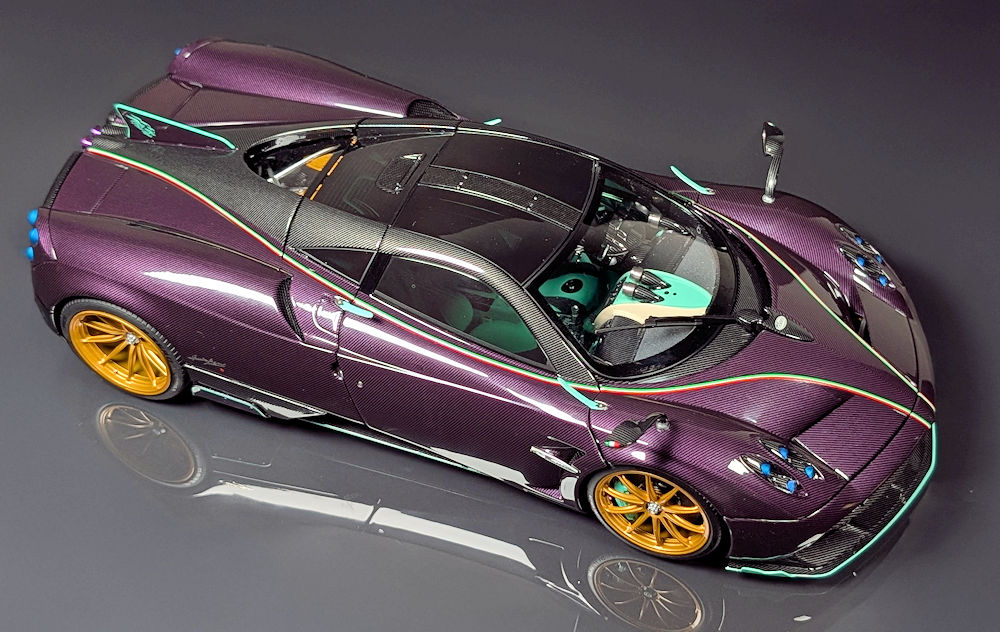
Beneath the sculpted carbon fibre skin, the Dinastia retains the same AMG-developed 6.0L twin-turbocharged V12 found in the standard Huayra. The engine churns out a staggering 730 horsepower and 1,000 Nm of torque. Power is sent to the rear wheels via a 7-speed sequential transmission, propelling the car from 0 to 100 km/h in about 3.3 seconds and on to a top speed of 370 km/h.
Back in 2017, Almost Real created quite a buzz when they announced plans to release various Pagani models. One of the most anticipated ones was the Huayra Dinastia. Fast forward to 2025, and after what feels like an eternity, I finally have the first of the Dinastias from their premium line (Almost Real +) in my hands. Was it worth the wait? Let’s “enter the dragon” to find out!

If you own any of their Zondas, the presentation and accessories will instantly feel familiar. The model is securely packaged in a styrofoam box. Neatly tucked into the top half of the styrofoam shell are a certificate, microfibre cloth, instruction booklet, prying tool, tweezers, screwdriver, and cross-bar wrench. Fortunately, the production isn’t limited, making the model attainable, unlike the real car.
Inside the box, the model is hidden away from sight under a soft fabric cover, adding a sense of mystery and excitement to the unboxing experience. Lifting the cover reveals a stunning exterior finished in deep purple carbon fibre.
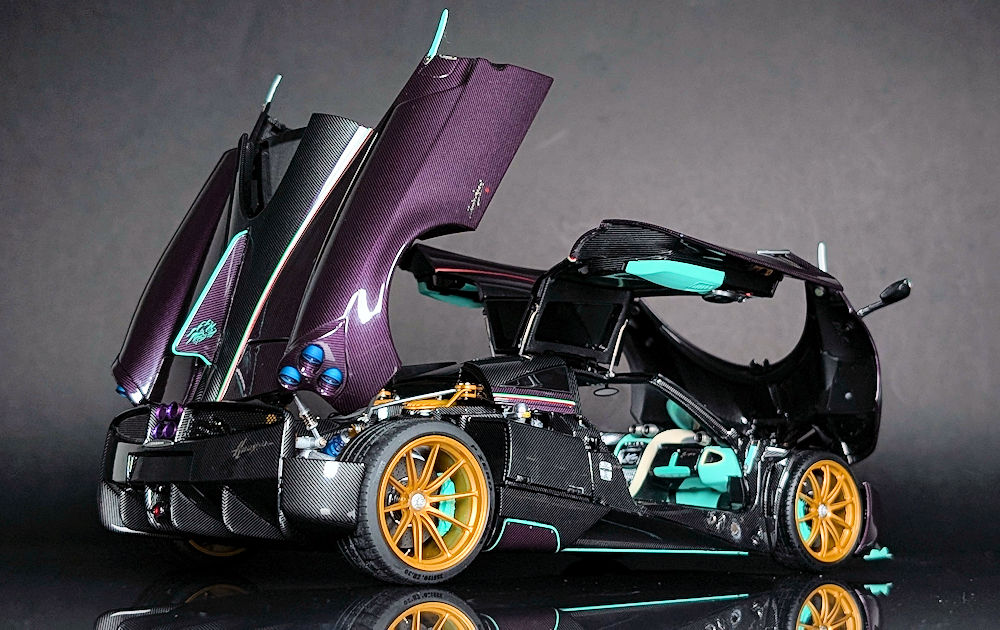
Dubbed the Yazi, this Dinastia features a slew of exterior enhancements. It is equipped with the Pacchetto Tempesta package, which includes an extended carbon fibre front splitter, a custom rear diffuser, bespoke side skirts and lightweight wheels. A fin mounted on the rear decklid with teal dragon motifs, and the Tricolore pinstripes sweeping from front to back are some of the other details that distinguish the Yazi from the standard car.
Almost Real has done a great job capturing the shape and stance, in my opinion. Nearly the entire body is finished in carbon fibre decals, and the execution is, hands down, one of the finest I’ve seen on a diecast model. The clear-coated exterior is glossy, smooth and consistent throughout. The weaves line up well overall, although a slight misalignment was observed between the front clamshell and bumper. That said, it is so minimal that most collectors won’t even notice it.
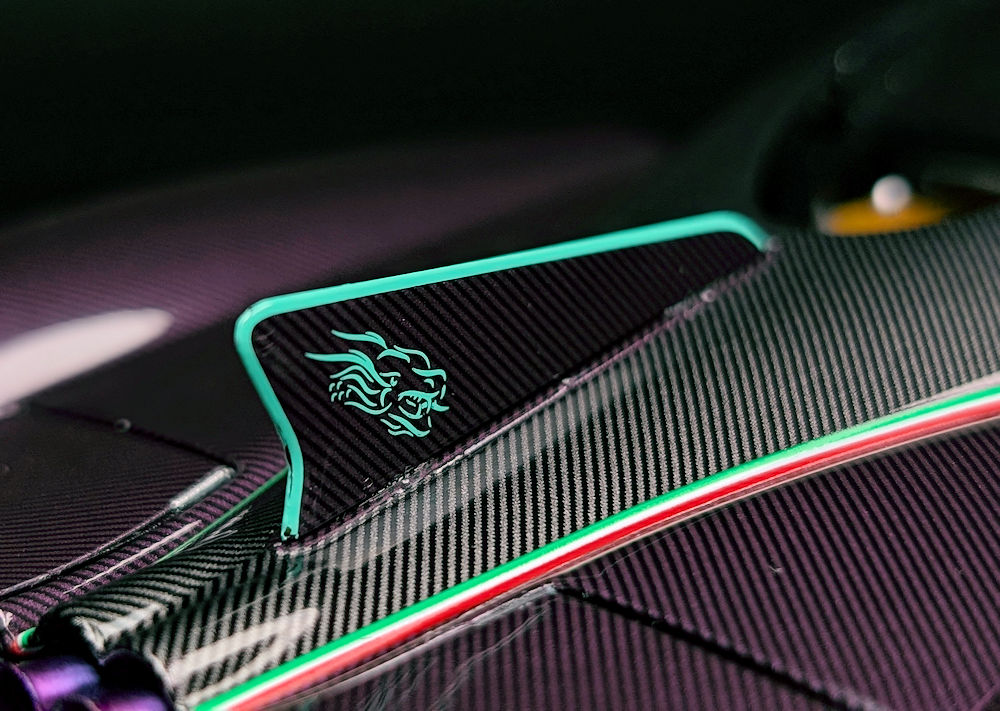
Teal accents are visible throughout the exterior and even carry through into the interior. While teal and purple aren’t colours I would think of pairing, the Yazi somehow makes it work. Perhaps I’ve warmed up to it over time.
The model weighs in at around 1.85 lbs and feels heavy in hand, giving you a sense of quality. Shutline execution is generally good, though the gap between the front clamshell and the doors could’ve been slightly tighter. Thanks to the dark exterior, the gap doesn’t seem as obvious.
In the front, the headlight and turn signal housings are finished in bright metallic blue, another detail that felt a bit out of place at first, but eventually grew on me. The headlights themselves look good and fairly realistic. The flaps located next to the headlamps are functional, and the operation is smooth. Moving up, the mirrors mounted on the front wheel arches are fixed in place and feature tiny Italian flag graphics on the tips. They are well-executed, and the stalks are not overly chunky. The Pagani badge on the windshield wiper trim is well-detailed and legible, and the Tricolore pin stripes on the body are neatly applied throughout.
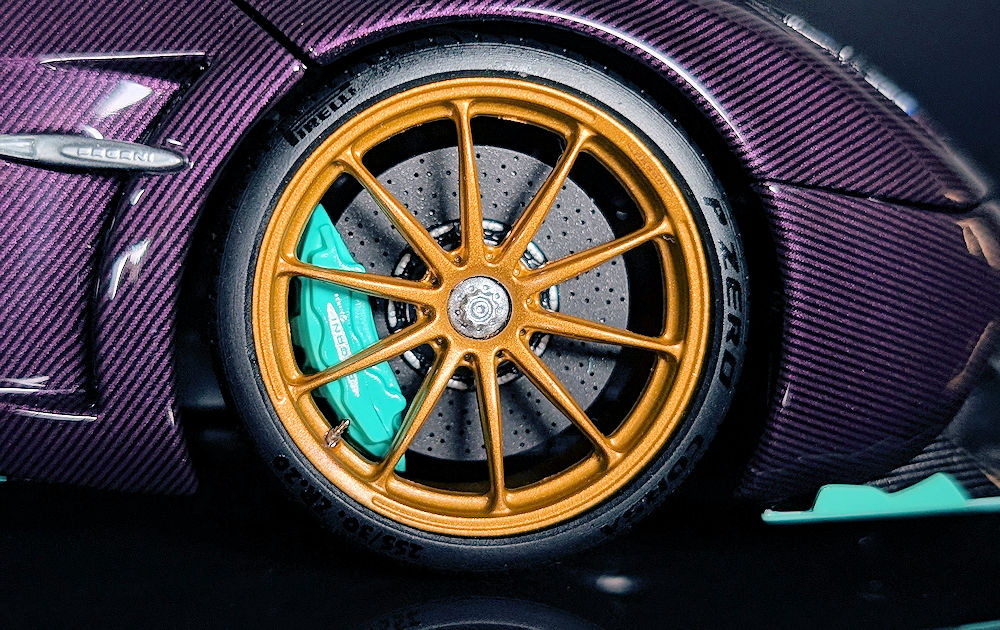
Moving to the side, the gold rims are captivating and impressive in their execution. Little details like the realistic-looking valve stems, Pirelli PZero Corsa branding and tire size on the side wall, and the Pagani logo on the rims work well to create an authentic appearance. Interestingly, instead of the Huayra logo, there’s a small “Roadster” logo on the rims, which is odd. It is, however, not very obvious, and you’ll have to look really hard to notice it. The carbon ceramic discs and teal callipers are faithfully reproduced. The wheels come with centre-lock nuts and are removable on the model.
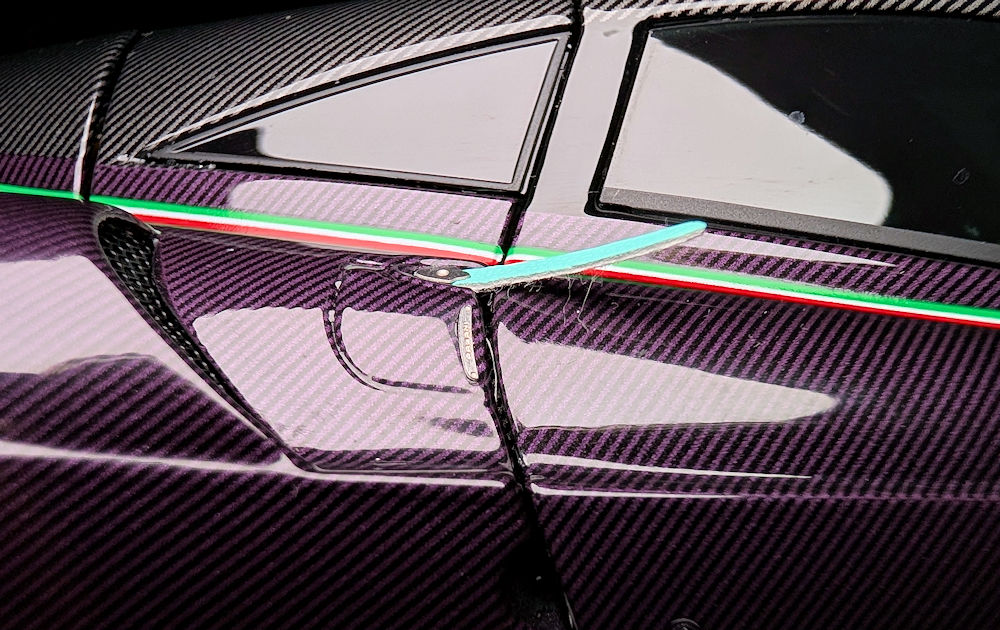
The teal-coloured leather straps securing the front and rear clamshells in place add a striking detail. Care must be taken when handling the straps, as they can easily tear if they repeatedly get caught between the clamshells and doors when opening and closing the model.
As you move further along the side, you’ll notice that the windows have a dark tint. The tint is also present on the sections of the roof that are glass. All the openings for the vents come with real mesh. Small but thoughtful details like the photo-etched Horacio Pagani signature and the black and red Dinastia Yazi logo are also included. The rear wheels, like the front, are also well-executed, but are slightly larger, as they should be. All four tires have the size printed on them, but they all read 20 inches, rather than 20 inches on the front and 21 inches on the rear. While this isn’t accurate, it isn’t something that bothers me.
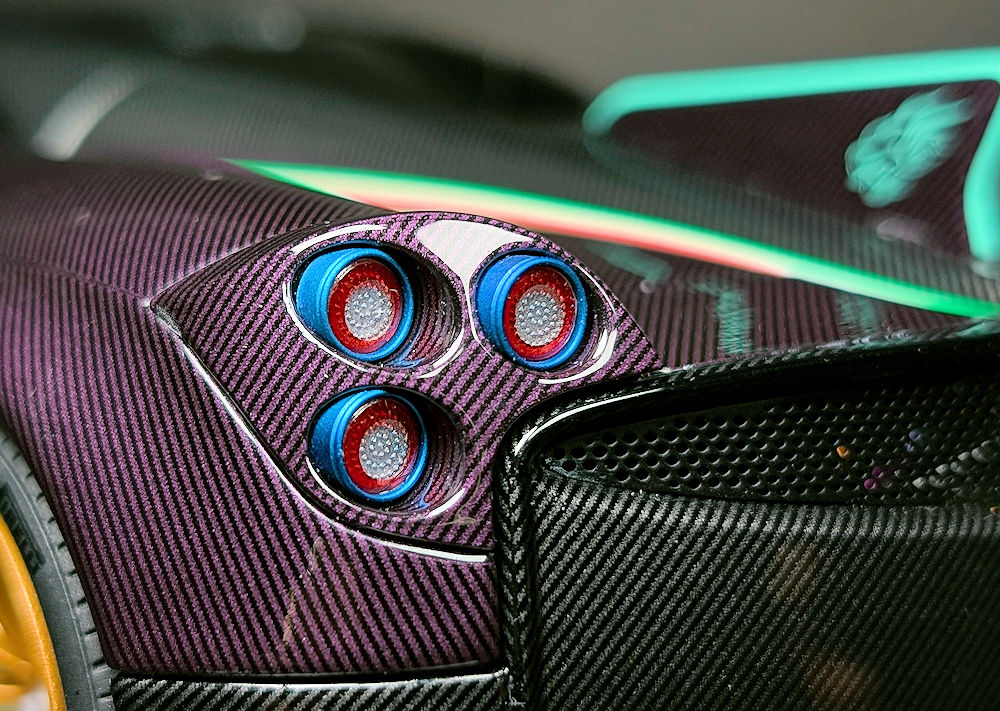
Shifting focus to the rear. The view from the back of the Yazi is just as breathtaking as the rest of the car. A window set into the rear clamshell provides a sneak peek of the intricately detailed intake plenum beneath. The rear flaps on the model are also functional.
The taillights are well-detailed and, as with the headlamps, are housed within metallic blue casings. Inside, a zillion LED bulbs can be found, which are neatly replicated. The hexagonal pattern seen on the lens covers has, however, been given a miss. The large oval grille between the two taillight assemblies is perforated, offering a glimpse into the engine bay, which we’ll come back to later. The mesh is accurately reproduced, and at the centre of the grille sits the iconic quad exhaust pipes, one of my favourite features on the car. The pipes are metallic purple, have excellent depth, and look impressively realistic. All the badges in the back look sharp and well-defined. The large rear diffuser is detailed in carbon decals, intricately applied around the fins and integrated fog light, rounding off a beautifully executed rear end.
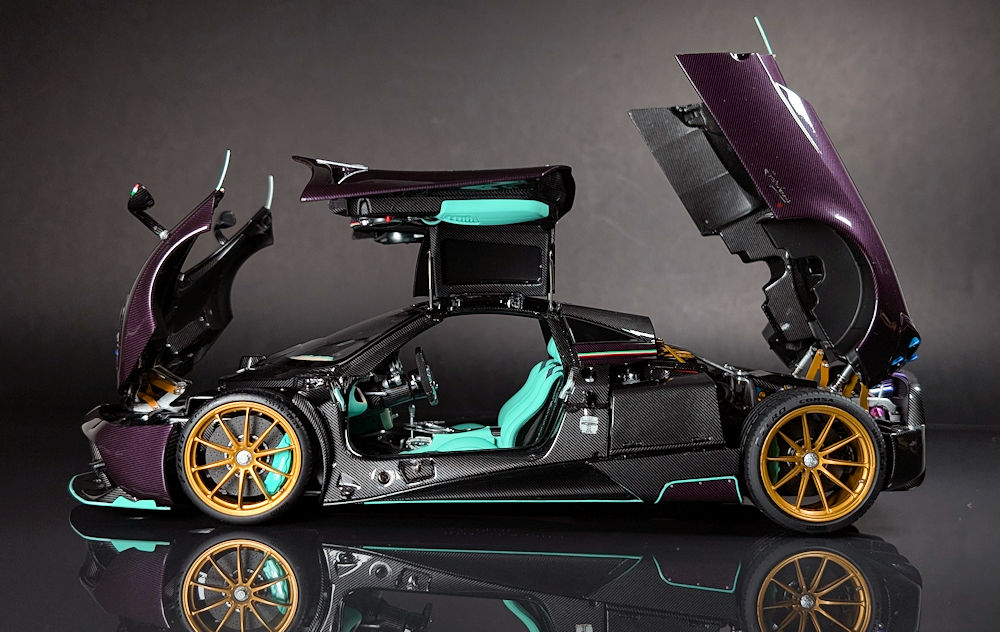
In addition to the doors, both the front and rear clamshells on the model can be opened. With all panels raised, the car looks quite dramatic, almost transformer-like!
The gullwing doors have a wide opening angle, and the struts and hinge mechanism work seamlessly to hold the doors in position. Once open, you’re treated to a stunning cabin, which is equally impressive as the exterior.
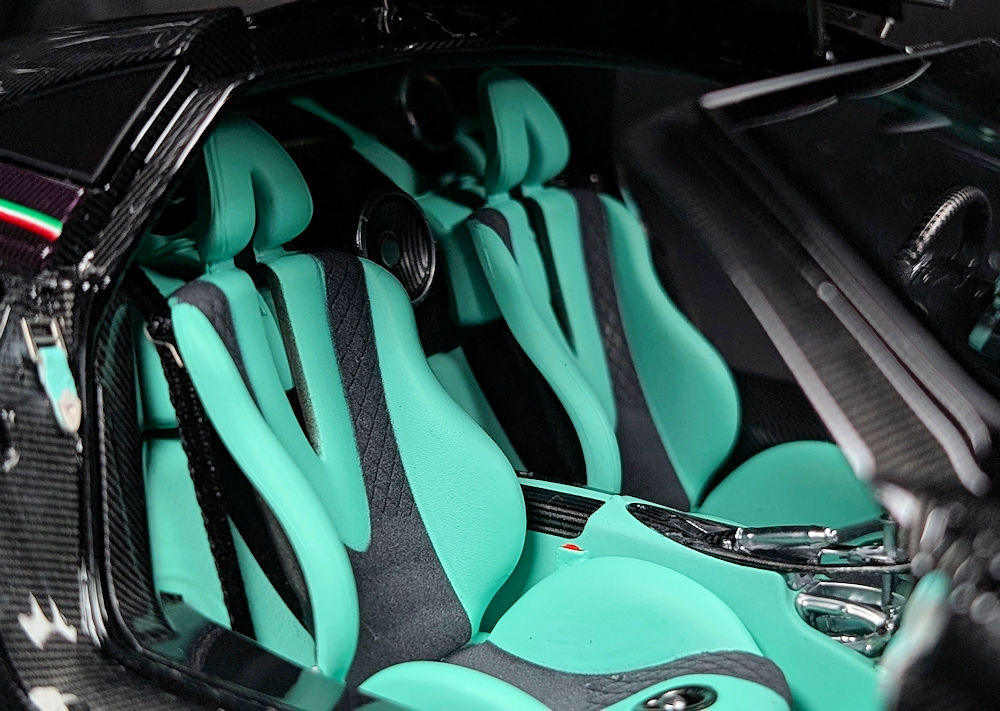
While the teal interior may not be to everyone’s taste, it undeniably stands out and gives the car a distinct character. Everything from the wide door sills and steering wheel to the glove box and seat backs is detailed in finely applied carbon fibre decals. Heck, even the speakers and the circular trim around the seat height adjustment knobs get the carbon treatment.
The top part of the dash is emulated to look and feel like Alcantara. This treatment carries over to the steering wheel and some of the trim in the seats as well, which feature a beautifully replicated diamond-quilted pattern. The leather sections on the seats, the floor mats, and the rest of the interior trim are painted in teal.
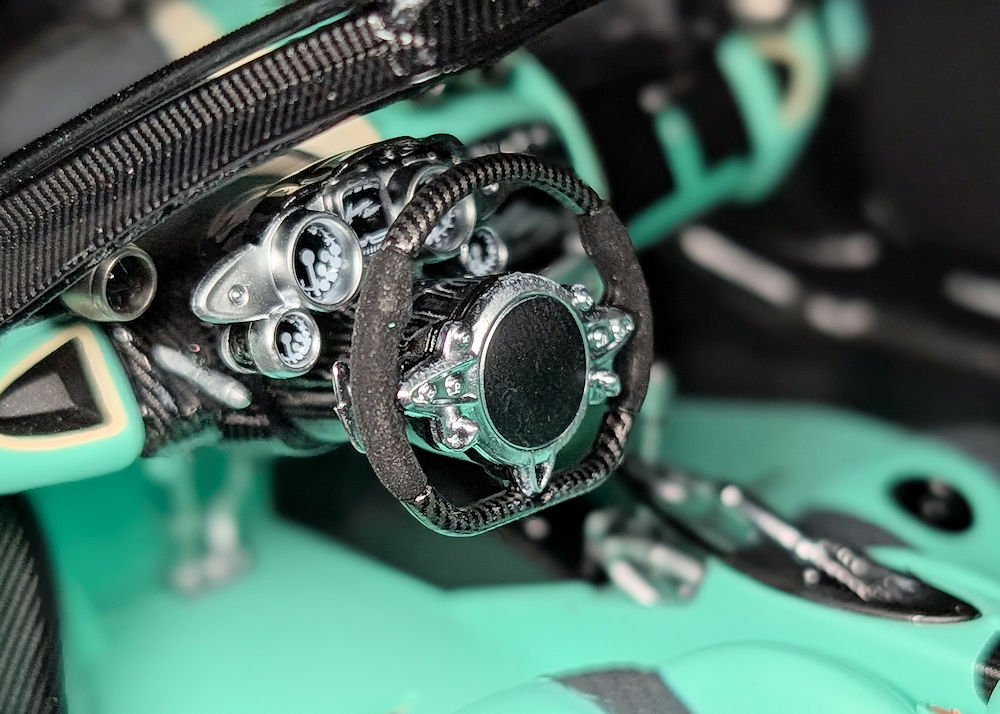
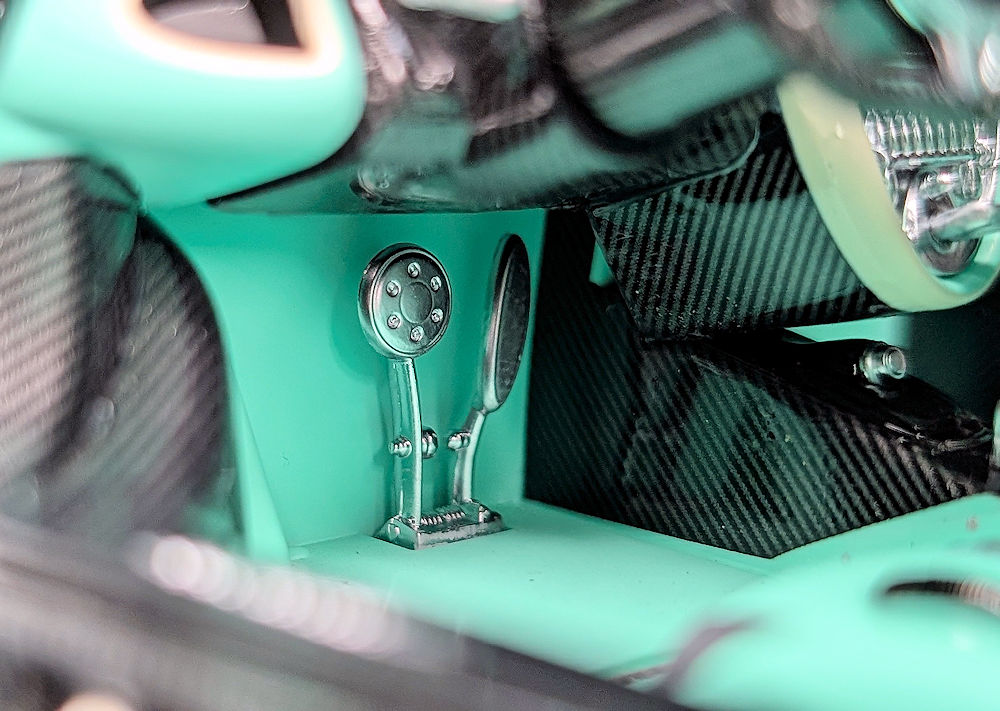
The centre console, gauge cluster and steering wheel are all well-executed. The exposed gear linkage mechanism looks quite intricate and convincing. All the buttons, knobs, and toggle switches are decorated to enhance the realism. The climate controls that are designed to mimic clarinet keys are also neatly reproduced, and unlike the Autoart Huayra (which skimped on some switches), Almost Real includes them all. If you take a closer look, you’ll even spot a tiny Huayra model casting sticking out of the centre console. If you’re wondering what that is, it’s the aluminum key fob, faithfully recreated and inserted in its proper slot, like in the real car. The combination of different textures, colours, and materials makes this interior truly special.
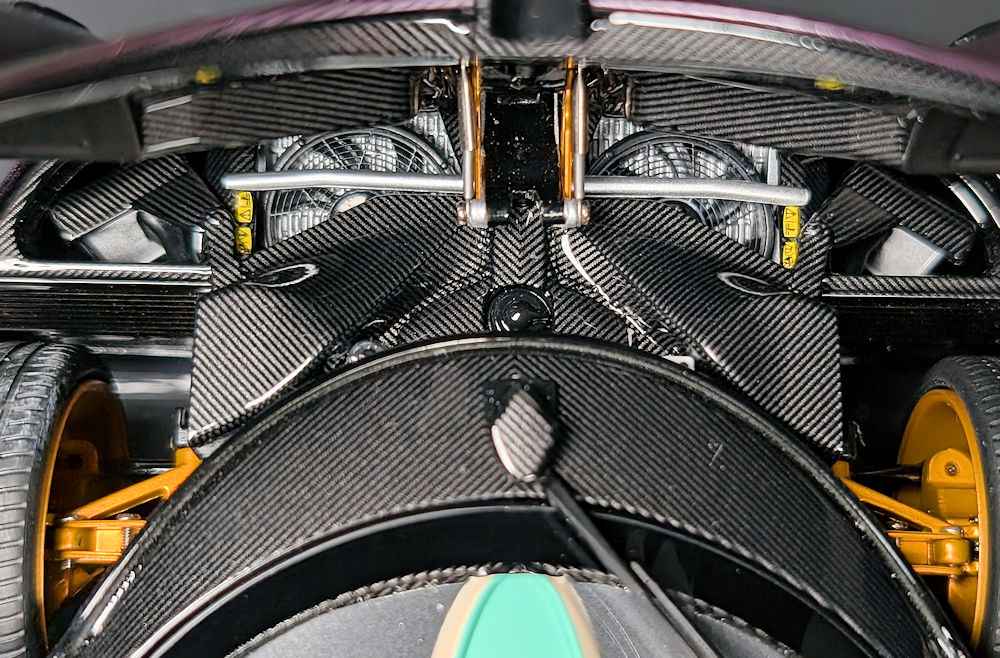
Before we dive into the engine, let’s first explore the front section and save the best for last. Lifting the front clamshell reveals the finely detailed radiator fans, intercoolers, crash structure, cooling ducts, fluid reservoirs, and meticulously crafted suspension components, all tightly packaged and finished with great attention to detail. The complex hinge mechanism felt a little wobbly, but the panel didn’t have a problem staying up. The model features a functional suspension and steerable front wheels. The carbon fibre detailing is expertly applied throughout, even extending under the flaps and along the underside of the clamshell. The inclusion of warning labels adds an extra layer of realism, and the overall execution is thoroughly impressive.
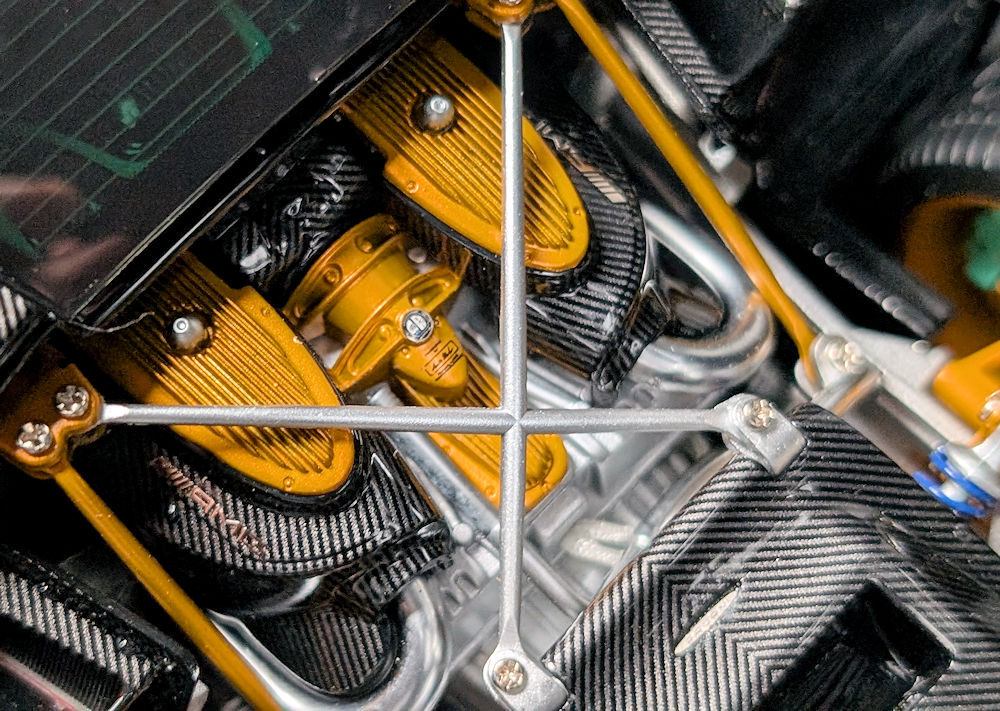
Finally, onto my favourite part of the model – the engine! In order to access the motor, the doors must be opened first, followed by the rear clamshell. It is important to note that when closing everything back up, the rear clamshell should be shut before the doors to avoid damaging the paint/decals.
The hinges and struts function well to hold the rear panel securely in place. As with the real car, the engine bay on the model is a visual masterpiece, showcasing a blend of artistry and engineering that is absolutely mesmerizing. Here too, carbon fibre work can be seen in almost every nook and cranny.
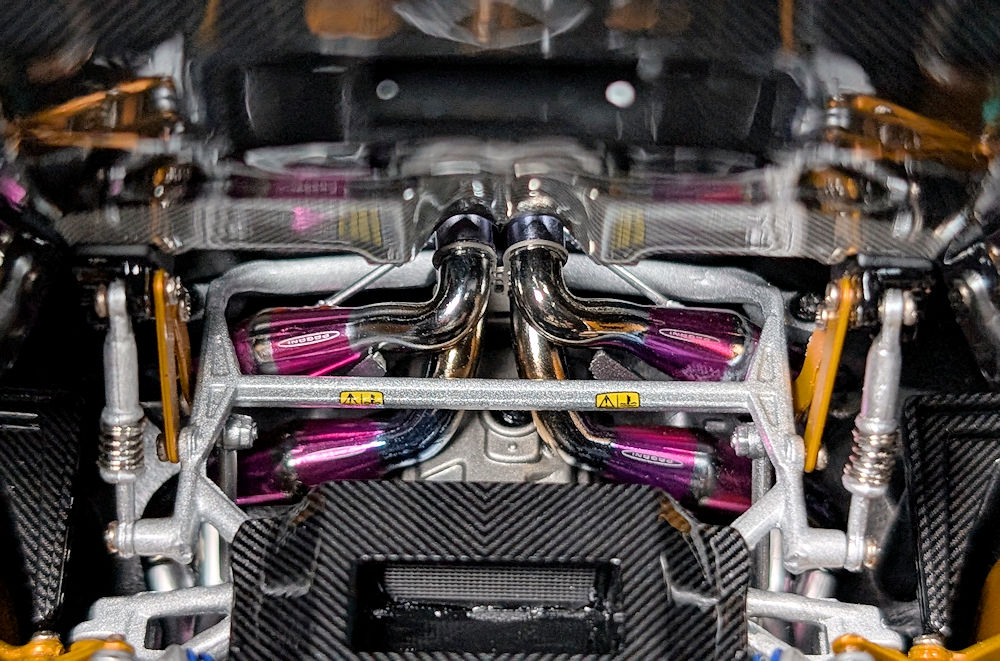
At its heart sits the hand-built AMG V12 engine, and an intake plenum in an anodized gold finish crowns the top of the powertrain.
The gold double wishbones and springs, which form part of the working inboard pushrod suspension, are stunning to look at, and watching them in action is an absolute delight.
The titanium exhaust system, mounted centrally just behind the engine, is another work of art. The bluish‑purple heat tint on the exhaust pipes, resulting from the thermal oxidation of titanium, is replicated masterfully.
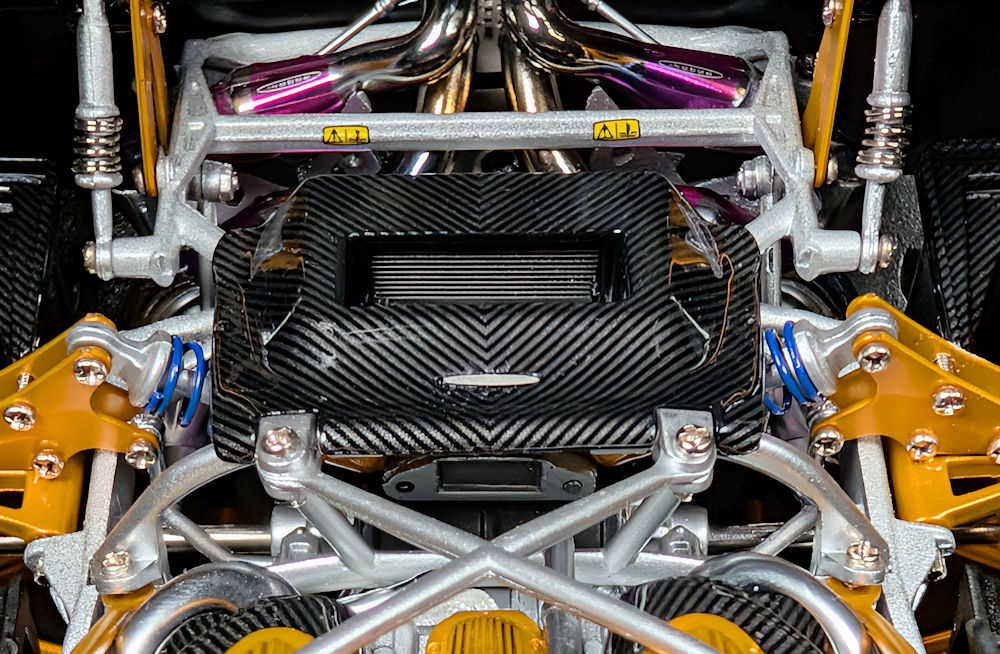
The inclusion of plaques and warning labels, combined with the neatly detailed fluid reservoirs, structural framing and the rest of the components mentioned earlier, adds a sense of complexity. On comparing the engine to that of the real car, a few cables appear to be missing. Although not very obvious, their inclusion could have further enhanced the model’s authenticity.

Present on either side are the carbon fibre luggage panniers. Almost Real even went the extra mile to include carbon detailing on the fitted luggage. If I have one complaint, it’s about these storage compartments. The covers are glued to the metal hinges and tend to come loose. I’ve heard a few collectors complain about it. Although they can be re-glued, Almost Real needs to find a more reliable solution to prevent this from happening.
Well then, with everything covered as best as I could, here are my final thoughts on the model. From the intricately detailed working suspension to the beautifully executed carbon fibre work, the model checks most of the boxes a collector could ask for. That said, no model is perfect, and the Huayra Dinastia from Almost Real is no exception.
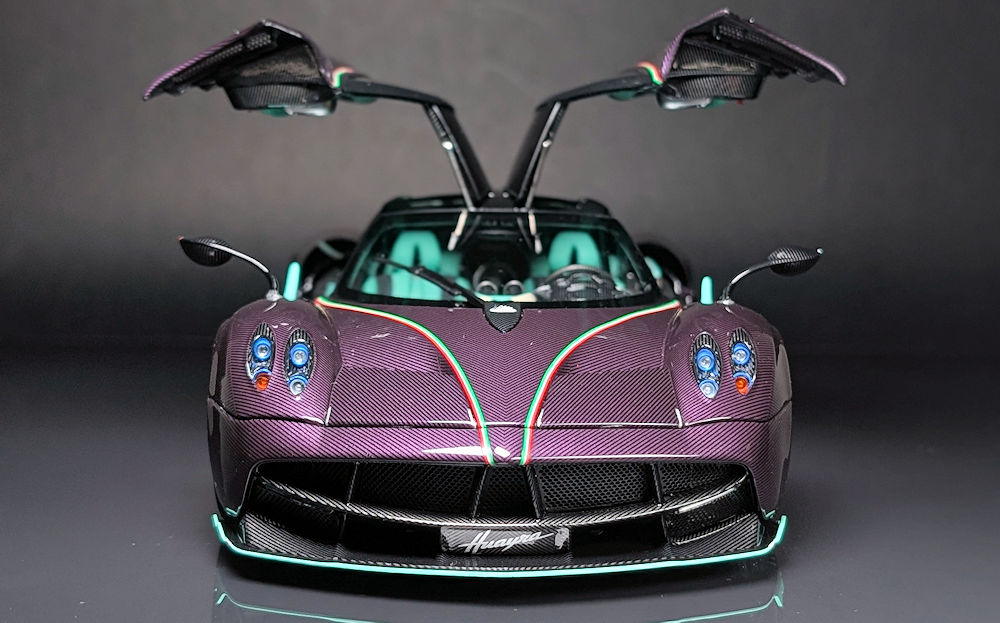
While the issue of the luggage compartment covers coming loose isn’t ideal, it can be fixed with a bit of glue. The steep price of nearly $600 CAD, shipped, however, can be a deal breaker for many. It’s certainly not affordable, but when you compare the model to an equally priced resin counterpart, considering the level of detail, the price begins to feel more justified. Furthermore, some collectors have reported slightly crooked exhaust pipes and rear fins on their models, though it doesn’t seem to be too common.
All things considered, Almost Real has done a fantastic job capturing the spirit and complexity of the real car, and I’d go as far as to say it’s one of my top picks for Model of the Year. It’s going to be a close fight, especially with LCD’s Huayra R in the running, but there’s no denying that this model from Almost Real+ is quite remarkable.


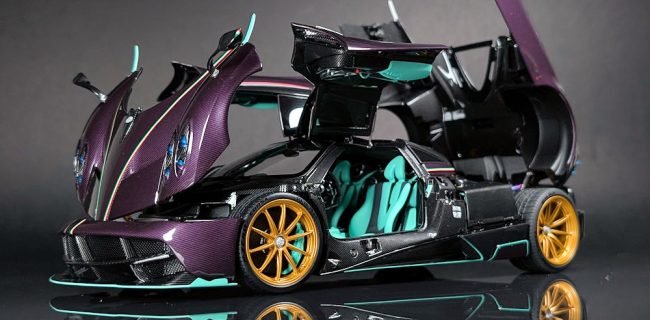




















































Scenic, this is an excellent review, and we agree with your assessment. This model is spectacular on so many levels. The intricate details are numerous, even down to the quality of peals on the interior side! Almost Real, in our opinion, has passed the best that AUTOart has provided to date.
On the flip side, this example does not come cheap! Tipping $600 CND. And being such a unique and what some would call an “over the top” Pagani, it may limit the number os perspective buyers.
We hope Almost Real will take their manufacturing skills and focus on new projects, possibly the Gordon Mueeay T.50 or the first to market with an opening Aston Martin Valhalla to name a few.
Almost Real can produce great models indeed, and this is definitely one of them. I love the exterior color. And I don’t like the interior color.
When Pagani Huayra was initially released, there was an absolutely brilliant combination of its interior colors: brown and black. There was a 1/43 model by Spark and a 1/18 model by Welly (if I’m not mistaken) with this interior color. That’s what I’d love to see here. Or maybe dark-red one. Not this light-green.
This is only their first Huayra. I’m sure AR will release a zillion specs of the car in the future, like they did with the G Wagon and Zonda. I just hope they explore other brands too and of course, produce more well detailed Ferrari diecast models for BBR.
Thank you for the kind words, it means a lot 🙌
I agree, this model from Almost Real+ is as good, if not better than quite a few Autoart Signature models, with superior carbon fibre execution, better interiors etc.
It is pricey for sure, but since the production isn’t limited, it gives collectors time to save up for one, unlike some brands like LCD that artificially inflate prices by releasing extremely small production runs, making them almost impossible for many to attain.
Oh yea! I’d absolutely love to have an opening GMA T.50, along with some well-detailed Astons like the 2012 DBS, 2007 Vanquish, the latest Vantage, Vanquish, and of course, the Valhalla!
“It is pricey for sure, but since the production isn’t limited, it gives collectors time to save up for one, unlike some brands like LCD that artificially inflate prices by releasing extremely small production runs, making them almost impossible for many to attain.”
Yes, it does great FOMO and artificial inflation of pricing. Translation: GREED!
AR should make Lambo Revuelto full-open
LCD already showed unpainted samples of the Revuelto in April. I won’t be surprised if Autoart makes them too in the future.
Thank you for this meticulously detailed and eloquently worded review! I must admit, though, that despite me being an avid Pagani fan and purple carbon being as delicious as all the details, I am put off by the teal, which is not AR´s fault of course.
What thrills me, though, is your observation of the Roadster script on the rims! While being inaccurate on this model, it gives me hope that AR have not abandoned their Huayra Roadster project, cutting costs by using the rims on the Dinestia AND (not instead of) the Roadster. Patiently hoping and waiting for it, I passed on the AA. With the AR Huayra Roadster sharing all of the attention to detail of the Dinestia (and why not?), it would make the wait well worth it! If all goes well, AR might be releasing the blue carbon variant they once showed as a sample and one in the same purple carbon exterior as this Dinestia, but then in the „Joker“ version that this American teen foolishly crashed. Although I next to never collect the same model in different colours, I would buy both of them.
My pleasure, Karsten! I really appreciate you taking the time to read the review. It means a lot.
I totally understand if you find the teal interior jarring. I’m sure AR will release the blue and brown Dinastias in the future. The blue carbon one should be a much safer choice.
I’ve been waiting for the roadsters as well, particularly green and blue carbon. I sold my blue carbon Autoart as the exterior finish on it left me disappointed.
Thank you for the scrutinized and usefull review. I shoul see this model before getting it. purple with gold rims and light green interior might be strange. AA and LCD bring for the pagani lovers full opening diecast models. hop all pagani lovers could buy every models they like.
You’re welcome Ali. I’m glad to hear it was useful to you.
Hi, I received mine. It has 2 issues. No markings on the tires. The front door is loose, like can be moved to sides. But at the end stay opened
Do you think I should return it or it is normal mostly the loose front door. Thanks
No, this is not normal. Based on price, request a replacement. Tire branding is shown here, so the “production” piece should ship like so. Good luck!
Thanks for the reply
I meant the front hood / clamshell is loose a bit but stays open, looks like the hinge is not very tight
Seller said the marking on the tires were not correct so AR has removed them in their new production!
I just checked my model and it’s pretty sturdy. I have seen a few examples that had a wobbly front clamshell but the issue was fixed after the screws were tightened.
I inquired about the tire markings, and apparently Almost Real released another batch later without the markings, as the first batch had them incorrect.
What about the huge gap between the medallion on the front bonnet and the other half at the base of the single windshield wiper ( when closed) ?!? I don’t remember seeing such a gap on any other 1:18 Huayra ( Autoart or LCD) ….
Very nice model and I’m interested, but I have a question. Given that I have the Zonda Cinque from Almost Real, I think the screws used on the engine are a little thinly disguised. The Zonda Cinque engine is much better. This seems even more evident on the LCD models. What do you think?
Hi everyone, really beautiful model.